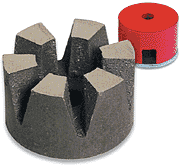ALNICO
MAGNETS
Alnico magnets are made primarily from aluminum, nickel, cobalt, copper,
iron and sometimes titanium. They can be either cast or sintered.
Cast Alnico
Cast alnico is melted and poured into a mold. Once solidified, the material
is rough ground and then heat-treated and cooled, sometimes in a magnetic
field. When treated in the presence of a magnetic field, the magnet is
called anisotropic. This orients the material to take on maximum magnetization
and allows a higher gauss level. A cast magnet that is not heat-treated
in a magnetic field is called isotropic. After heat treatment and cooling,
the material can be ground to specific tolerances and then magnetized. Attributes of Cast Alnico Size parameters range from 1 ounce to about 70 pounds
Will cast to a variety of shapes and sizes
Sintered Alnico
Sintered alnico is made from a powdered mixture of ingredients that are
pressed into a die under tons of pressure, sintered in a hydrogen atmosphere
and then cooled either within a magnetic field or without (anisotropic
vs. isotropic). Attributes of Sintered Alnico Size parameters range from about one ounce of material up to one cubic
inch
Pressed to close tolerance/minimal grinding to finish
Mechanically strongest of alnicos
Attributes of Both Cast and Sintered Alnico Very temperature stable, great for high heat applications
Maximum working temperature 975° - 1020° F
May be ground to size
Does not lend itself to conventional machining (hard and brittle)
High residual induction and energy product compared to ceramic material
Low coercive force compared to ceramic and rare earth materials (more
subject to demagnetization)
Most common grades of alnico are 5 and 8 |

Alnico Bar |
|
|
Applications of Alnico Magnets
Magnetos, separators, sensors, electron tubes, traveling wave tubes, radar,
holding magnets, coin acceptors, clutches and bearings, motors, distributors,
relays, controls, generators, receivers, telephones, microphones, bell ringers,
guitar pickups, loudspeakers, security systems, cow magnets.
Tolerances
Unless otherwise specified, our tolerances on alnico material meet and
often exceed International Magnetics Association (IMA, formerly MMPA)
standards. For unfinished surfaces (as cast) the following tolerances
apply: 0-1” ± .016 1-3” ± .031 3-5 ± .047
5-7” ± .062 7-9” ±.078 9-12” ± .094
Finished surfaces are normally ground to ± .005 (See MMPA standards
for more details.)
Magnetizing and Handling
Magnetizing is done after the magnet has been machined to the correct
tolerances. Care should be taken when handling alnico material since it
is brittle and can chip or break if dropped on a hard surface. Also, because
it has a low resistance to demagnetization, it will lose power if it is
stored improperly (poles repelling each other). For best results, store
magnetized alnico so that pieces are attracting each other, or with a
steel keeper.
Machining
Alnico is a very hard and brittle material and does not lend itself to
conventional machining. ALL Magnetics Inc. employs experienced machinists
and the proper equipment to grind alnico to its required dimensions.
|
|






